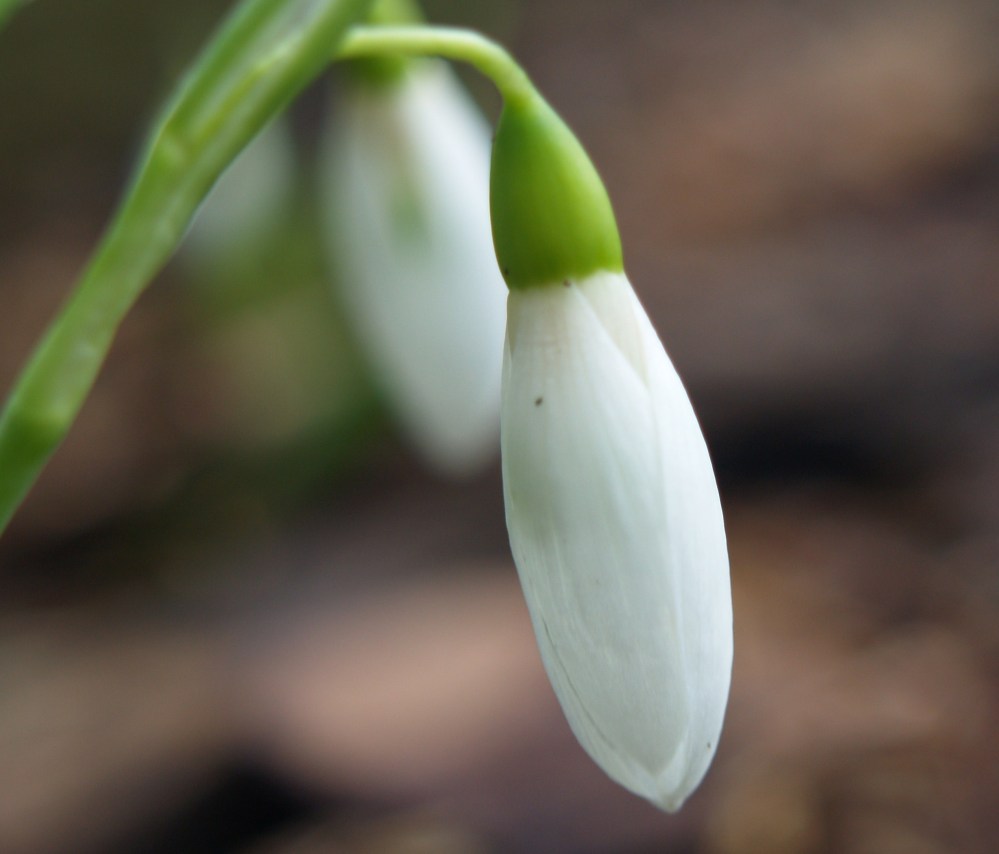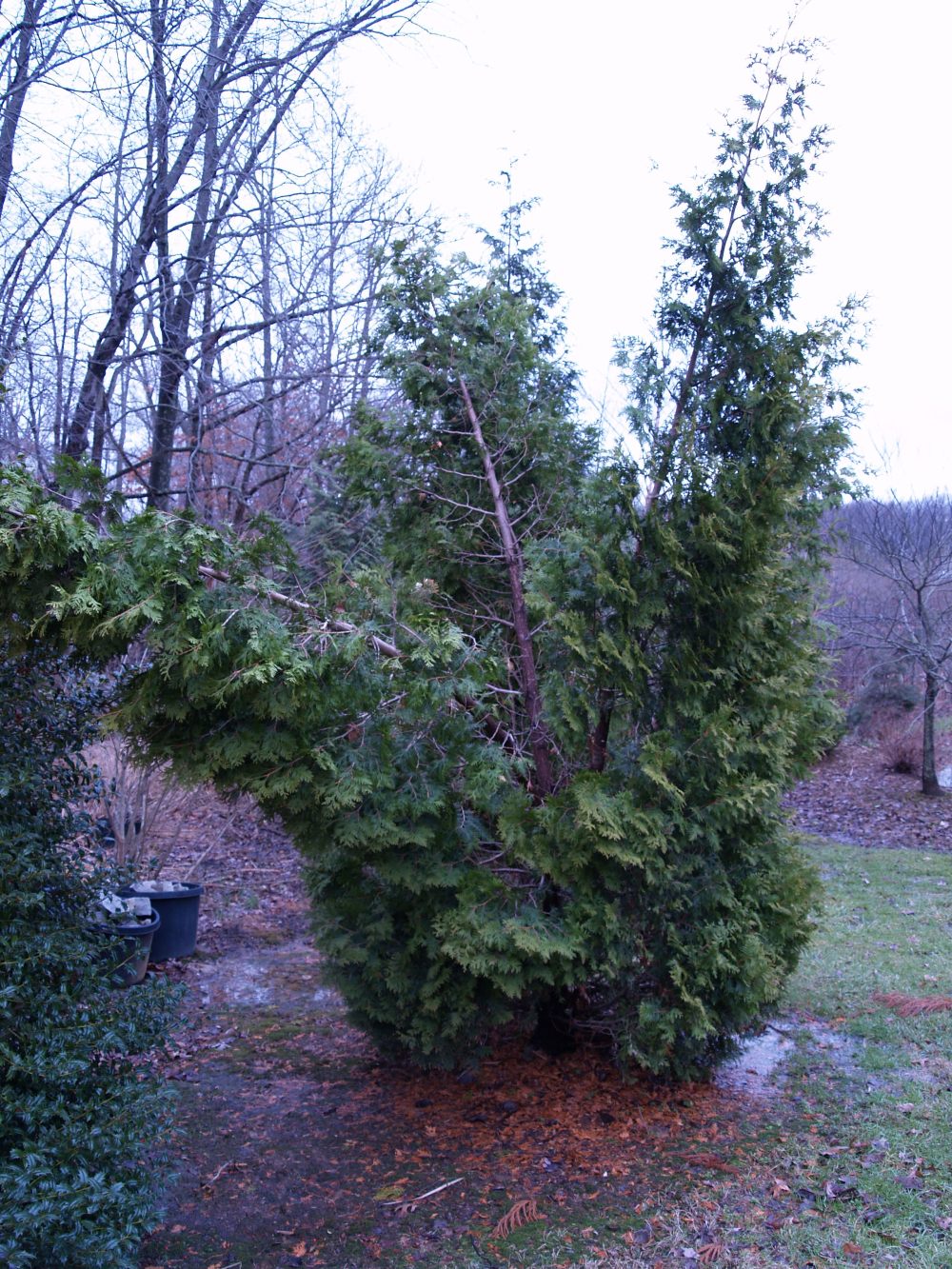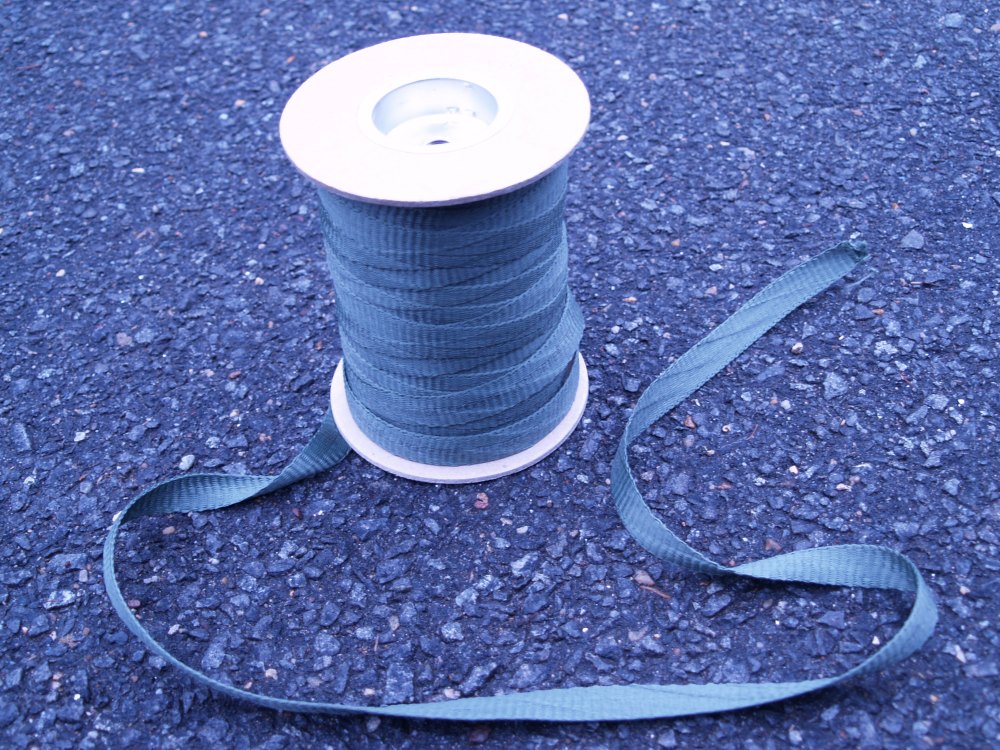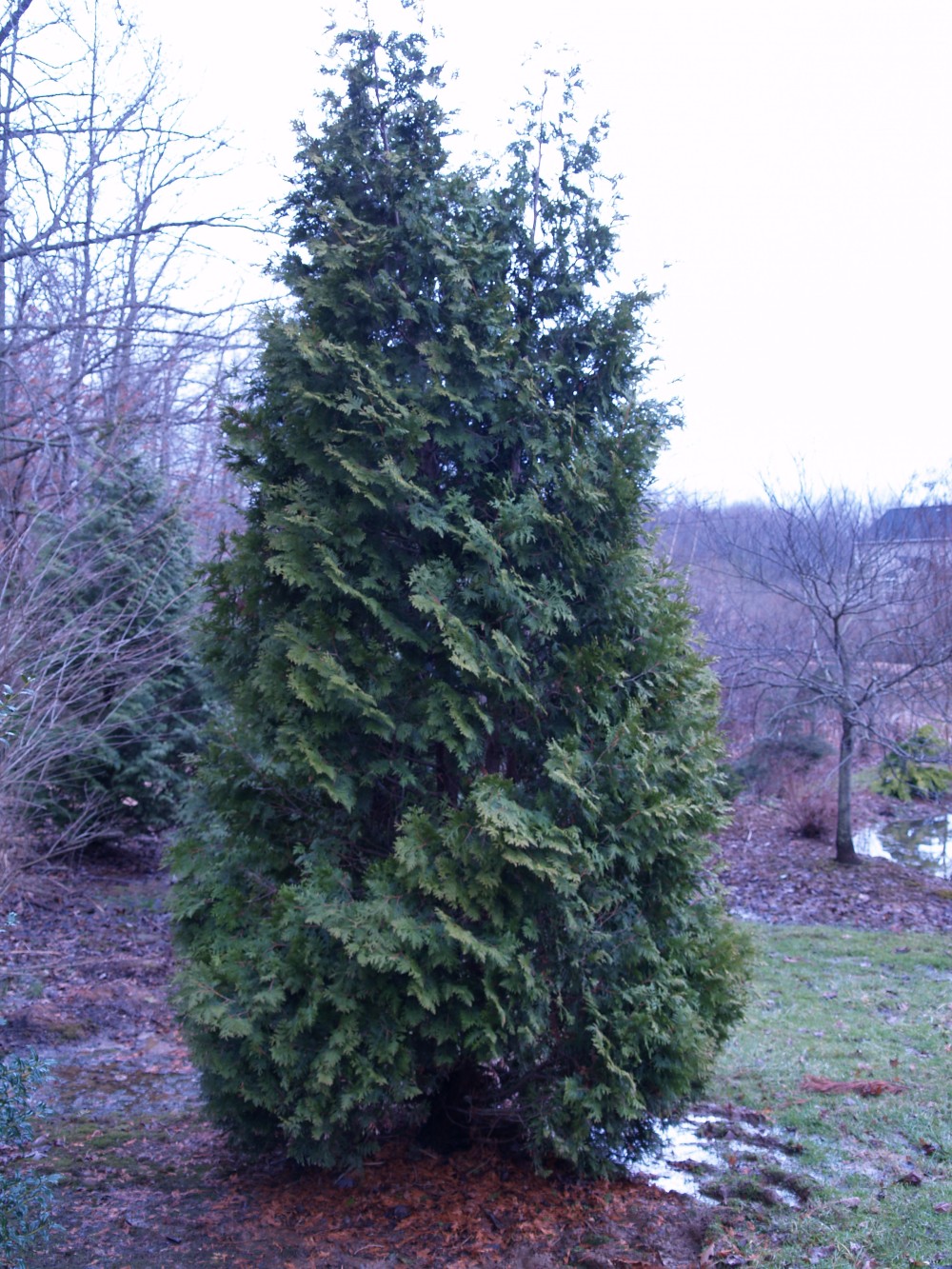Undeniably, spring has arrived! Helleborus and snowdrops (below) have emerged from their snowy blanket to burst into bloom, yet much damage from the winter storms remains (though considerably less than many gardeners feared).
In the past weeks we’ve addressed how to prune the broken and split branches, what to to do with the large evergreens that are leaning, or roots that have been ripped from the ground. These are the most distressing results of the heavy snows, with many trees beyond salvage, but we have yet to discuss the evergreens that were buried and bent. Some have sprung back nearly to their usual shape, others only partially, their upright branching interupted by branches splayed at odd angles. Do they need help, or will they shape up without our assistance? And, what can we do to repair our bent and broken plants?
This is somewhat uncharted territory since I’ve had this happen only once, on a columnar blue spruce a number of years ago. I was successful in saving the tree then, and I expect it will work this time. The branches of my spruce did not bounce back many weeks after the snow had melted, so it was clear to me that the form of the tree would suffer if I didn’t lend a hand. I expect the same with many of the arborvitae (a twelve foot tall gold arborvitae with branches splayed in my garden, below), junipers, boxwoods, and other evergreens that remain bent out of shape today.
Years ago I used a length of clothesline rope to tie around the branches, drawing them back into a semblance of their original position. Today I’ll be using a thin nylon strap called ArborTie (below). Why not string, twine, or rope? These materials will work, but are more likely to dig into the soft wood of our evergreens as we pull it tight, and though the injury is superficial ArborTie will do the job without inflicting further damage.
Circle the strap around the tree and tie a loop so that you can pull it tight. Lift the strap so that it catches the major branches and pull tight enough to pull the branches into a bunch that is a bit tighter than the normal shape. Circle the strap a few more time to catch some of the smaller branches, then tie the strap to a larger branch to secure it. I will plan on leaving the strap in place through the spring before removing it (the photo below is the damaged arborvitae after I tied it with ArborTie).
When the ArborTie is removed while the plants are actively growing they are likely to droop a bit, but will be much better off than if we had done nothing. However, this won’t work for all.
In my garden the branches of a Gold Cone juniper (a more colorful introduction of the old Irish juniper that fell into disfavor because it browned in the middle and often fell victim to snow damage) have bent to a severe angle (above), but the branches are not substantial enough to pull them upright.
I have pruned a foot off the top (above), then tied the stray branches and wrapped a length of the strap to secure most of the smaller branches. A few branches that couldn’t be captured by the strap were pruned off. I will be certain to remove the ArborTie later in the spring or the tightly wrapped stems will cause many brown needles from a lack of air circulation.
Some brittle, woody plants, such as azaleas and andromeda (Pieris japonica) will be difficult to tie because they are likely to break rather than bend back into shape. In some cases I’ll have to prune these severely, but I’ll wait several weeks longer to give every opportunity for them to rebound.
At long last our lessons are over. We have addressed most of the damage inflicted by the winter’s storms. Milder temperatures have returned, and we’re ready to get outside and tackle the tasks ahead.
Now I can get to work on my own garden.
Great job tying up those trees! We had a lot of snow damage in the winter of 2008-09, so I can relate. But this winter was really warm due to the El Nino effect.
The tall arborvitae was a bit of a struggle with long, heavy branches, and if you look closely at the after photo, I was getting shorter with each step. Between the melting snow and almost two inches of rain the previous day the ground is a swamp, and I was sinking nearly to my ankles.
It would have been far easier to save this task for a drier day, but I had set a deadline to get this topic out rain or shine.
Dave,
thanks for the tip about the split tree tying! I ended up using what I had on hand (not unusual for me) which was fiber pulling webbing, aka mule tape, but i think the idea is the same. Its something strong but wide that won’t cut into the trees.
I had two of my evergreens get crushed by an avalanche of snow that came off my roof. One split and one about got knocked clean over.
I had to dig around the backside of the one to re-plumb it since it was knocked at about a 45 degree angle from the weight of the snow. Think it will recover ok? I tried my best to keep away from the root ball.
thanks for all the great info!
I’m glad that you were able to save these evergreens. For any that have had root problems (those that have blown out of the ground, or blown crooked) it will be important to watch their watering once the ground dries out. It’s inevitable that there has been some stress from the root disturbance, and if we should go into a prolonged dry spell these plants could suffer. A week without rain won’t hurt, but if it goes any longer, and the ground seems dry, then it would be advisable to water.
What about Japanese maples, will they survive the wrapping?
I have one that suffered a spit in one branch, but I notice the ends are still alive. How long do you leave the tie on? I have rescue an azalea a previous year and it worked, but I no longer live in that property to see how it is doing
Are Japanese maples sturdy plants? I was delighted to have two of them in my new house.
Thank you .
Adriana
Under ideal circumstances a split branch on a Japanese maple will heal if the two parts that have separated are joined closely. On large trees this is done with a hole being drilled through the branch and a bolt that holds them together. For smaller trees, including Japanese maples, anything that tightly binds the split portions of the branch will do. If the exposed part of the wound has not suffered too much damage from prolonged exposure over the past month and a half since the injury occurred, new growth might knit the parts back together. I’m guessing, but if the union is not secure by June then I doubt this procedure will be successful. There is a reasonable chance that it will work.
Please help me with my rhododendron that received extreme damage from the snow. Many branches have been broken but are attached by threads of the branch. The buds seem to be coming along but the bush is a mess! Should I cut off all that is broken, which will not leave much, or wait until after blooming to prune, or simply did it up??
If the branches are broken too severely then the flower buds might not make it until blooming time. If fluids are not able to flow through the plants’ tissues from root to stem then the branch is very much like a stem that has been cut and brought indoors to bloom in the winter. If allowed to dry out the flower bud dies. Most rhododendron bloom in the mid Atlantic region in early to mid May, so if the branches are broken and hanging then it is very unlikely that the buds will last that long and bloom. If the break is only partial, then there is still a possibility that it will bloom.
If you judge that the broken branches are too severe then it would be a good idea to prune the branches as soon as it’s convenient. Rhododendron don’t send new growth until after their blooming time, but they should send new growth from just below the pruning cut, unless they are large, old main branches which are less likely to have growth buds. It is important to prune back to another small branch, or an area that you can tell had a branch at one time.
Dave, what if the cedar is 20 feet tall? My two story tall cedar suffered the same fate in the snow and has some tall branches bowed over from mid height on. However, there is no way I can reach that tall on the tree, maybe from the ladder but I cannot circle the tree that way. How is it possible to circle the tree at that height? Will the tree recover if it is left alone or do we have to prune out the bent branches? (a very unhappy thought as it will leave holes in tree!)
It will be very difficult to tie and draw together the splayed limbs of a twenty foot evergreen. For a plant this large I would suggest getting a professional evaluation whether it can be saved or if replacement is the only practical solution. At this point in late spring I doubt that the bent branches will move at all if no action is taken. The weight of the branches and the safety in working this far off the ground make this a job for a professional.
Great tip! I see this all the time with arborvitae. The gem in this post is the use of ArborTie. Too much use of the wrong staking materials out there doing more damage than good. ArborTie is what we use. Also…and Dave mentioned this…remember to remove the stuff — Do Not leave staking/support material for more than one season.